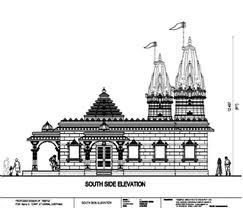
Indian Hindu temples are the most visited places in India. Indian Hindus like to share every sorrow, success, and prosperity with Indian Hindu gods.
The people of India have lots of faith in God. The home of the Indian Hindu God is a temple. You can set up a temple inside your home also. Prayer and worship of God improve our health and happiness.
Hinduism’s place of worship is an Indian temple. The Hindu temple near you is a great source of positive vibrations and wellness.
Why I am discussing all these things over here? Here I am going to discuss Hindu temple facts.
Table of Contents
Related: Benefits of Gayatri Mantra
How do Hindu temples give peace and positive vibration?
Why are Indian Hindu temples in aerodynamic shape?
Let’s begin with the facts about Hindu temples
Most of our Hindu religious people visit temples to show their respect and love for their religion and culture. Very few people know about the science of temples and their various energy secrets. We are going to remove the curtains over the science behind the Indian Hindu temple.
INDIAN HINDU TEMPLE SHAPE
The aerodynamic shape of Hindu temple heads, also known as shikhara, is a result of architectural and aesthetic influences. The shikhara is a prominent feature of North Indian temple architecture, particularly in the Nagara style of temple architecture.
One of the main reasons for the aerodynamic shape of the shikhara is to symbolize the cosmic mountain, Meru. In Hindu mythology, Meru is considered to be the center of the universe and the abode of the gods. The shikhara is designed to resemble this cosmic mountain, with its curving and tapering shape representing the upward movement of the soul toward the divine.
Another reason for the aerodynamic shape of the shikhara is to provide an illusion of height. The shikhara is typically the highest point of the temple, and its tapering shape makes it appear even taller. This serves to create a sense of grandeur and majesty and to emphasize the importance of the temple as a sacred space.
The shikhara is also designed to provide a functional purpose. Its curving and tapering shape helps to channel rainwater away from the temple, preventing damage to the structure. Additionally, the shikhara’s shape provides stability and support for the weight of the structure, which is typically made of heavy stone or brick.
In addition to these reasons, the shikhara also has aesthetic value. The shikhara is often decorated with intricate carvings and sculptures, depicting scenes from Hindu mythology and the life of the deity to whom the temple is dedicated. These carvings and sculptures are typically arranged in horizontal bands, known as moldings, which further enhance the aerodynamic shape of the shikhara.
The shikhara is not only an architectural feature but also a symbol of spiritual aspiration. It represents the path to enlightenment, the ascent of the soul towards the divine, and the attainment of spiritual liberation. The shikhara serves as a reminder that the ultimate goal of human existence is to transcend the material world and merge with the ultimate reality.
In conclusion, the aerodynamic shape of Hindu temple heads is a result of architectural, aesthetic, and spiritual influences. It symbolizes the cosmic mountain, Meru, provides an illusion of height, serves a functional purpose, and is decorated with intricate carvings and sculptures. The shikhara is not only an architectural feature but also a symbol of spiritual aspiration and a reminder of the ultimate goal of human existence.
The shape of the Indian Hindu temple head shape is aerodynamic. The aerodynamic shape structure of the temple head and conical upper head attracts the positive charges from clouds. This Positive energy covers the whole internal surroundings of temples which provide positive thinking, mind, peace, and health.
Sitting some time in the temple after worshiping gods and goddesses gives you solutions to your life problems.
The aerodynamic shape of a temple also reduces the natural disaster losses like an earthquake.
AERODYNAMIC SHAPE REDUCES EARTHQUAKE LOSSES
The aerodynamic shape of the temple reduces natural disaster losses. According to science, earthquake waves generate the vibrations of the earth. This earthquake vibration when reaches the aerodynamically shaped temple, rotates the vibrations on the boundary of the aerodynamic structure of the temples. According to aerodynamic science aerodynamic structure reduces the earth’s vibration losses.
Related: Life and Health Enhancer No Cost Lord Shiva Mantra
INDIAN HINDU TEMPLE LOOKS ATTRACTIVE
The aerodynamic structure of the temple head looks attractive and eye-catching. According to recent research by London scientists, temples have more waves of positive energy as compared to other structures of the world.
Conclusion
The benefits of the aerodynamic structure of temples provide positive energy from the clouds, reduces earthquake losses, gives an attractive look, etc. still there are so many reasons behind the aerodynamic structure of the temple.


